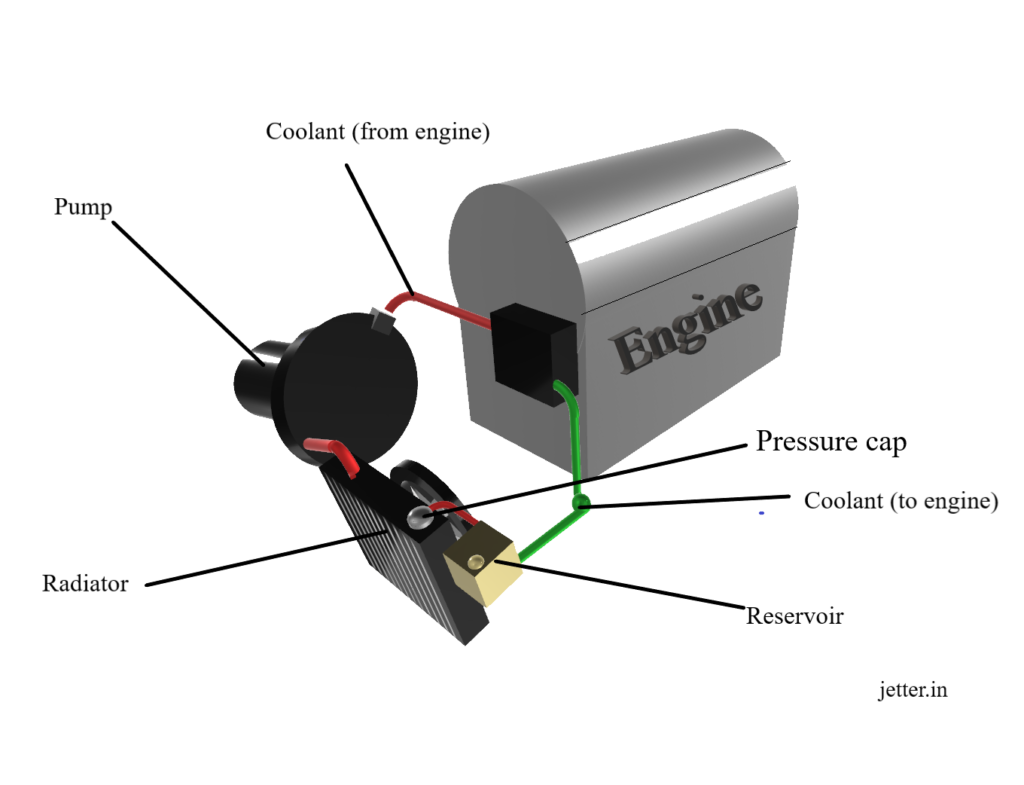Cooling system is something without which any vehicle on the road can run. Even electric vehicles are employed with cooling systems in order to cool the batteries or the fuel cell. Cooling systems helps from Engine Knocking . Apart from the cooling systems, exhaust gases and lubricating oil takes away some of the heat generated in the engine.
Table of Contents
Components of a cooling system
- Radiator
- 2. Radiator fan
- 3. Pressure valve
- 4. Coolant tank
- 5. Thermostat
- 6. Temperature sensor
- 7. Pump
Working

This is a cyclic process and the coolant is generally R-134a. The whole cycle is described below.
For the sake of cooling, there are passages in the walls of the engine called cooling jackets and the coolant passes through these jackets and heat is transferred to the coolant from the engine. Note that the coolant must have good thermal conductivity and high specific heat so that the efficiency is better.
As I said before that the engine oil takes away some amount of heat produced, the cooling system is responsible in cooling the lubricating oil. This is done in the oil cooler. Then the hot coolant is transferred to the upper end of the radiator and a pump present in this line is responsible to maintain the flow of the fluid throughout the cycle. The radiator is essentially a heat exchanger and it transfers heat from the coolant to the atmosphere by forced convection. Behind the radiator, there is a fan which helps in better heat transfer.
The radiator has brass tubes which is laid in a zig-zag fashion from to bottom through which the coolant flows and as the coolant reaches the bottom, it is cooled to the required temperature. To improve the heat transfer, there are fins attached to these pipes to increase the surface area of heat transfer. More about fins click here.
Also, there is a Pressure cap on top of the radiator which transfers the excess coolant to the reservoir (Click the above link for more info on the effect of pressure in cooling system).
The coolant is cooled and is ready to be sent for the next cycle and if the pressure level in the line drops, some coolant is drawn from the reservoir and they enter the engine via the coolant flange. This has a thermostat and a temperature sensor.
Thermostat

Thermostat is a valve and it helps in maintaining the engine temperature. The thermostat allows the coolant to pass through only when the temperature of the engine is beyond a critical level. In the absence of the thermostat, the system circulates the coolant all the time which is a waste of time, also it might reduce the engine temperature below its working temperature reducing its efficiency and it is a headache during starting the engine.
Temperature sensor
The temperature sensor gives one of the most important data to the ECU (Engine control unit), the engine temperature. If you guys are not aware, it is the coolant temperature which is used to find the temperature of the engine. And it is responsible for ignition timing, best air fuel mixture. Also, the radiator fan doesn`t run all the time only when the coolant temperature is considerably high, the fan is switched ON. You can notice the fan`s sound every now and then.
Cabin heating system
Heaters in the cabin take the heat of the engine through a heat exchanger placed in the hot line of the coolant cycle. Thus, the energy is not wasted.
My advise to you is that, if you find some problem in your cooling system, never start the engine. Make sure the problem is fixed and then proceed. Also, never forget to check the coolant level in the reservoir.
